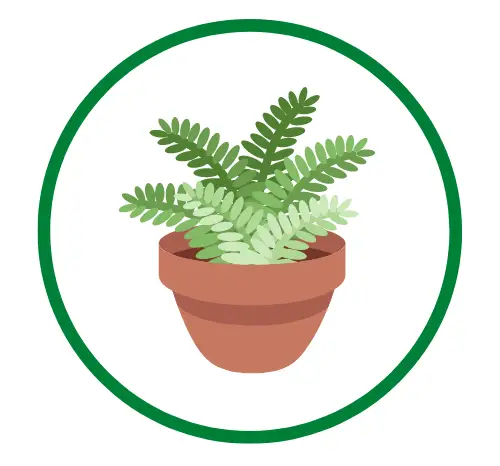5 Best Humidifiers For Plants Reviews

Plant humidifiers! Such a device might not even exist if you reside in a tropical nation. After all, it’s warm, muggy air all the time. However, it is uncommon to find that ideal humid climate elsewhere in the world. For the majority of people, that’s fine, but if you’re a budding plant collector, you should be aware that a lack of humidity in your home can be a significant problem.
Numerous gorgeous indoor leafy plants that we adore seeing in people’s homes and on social media are tropical plants! Rainforests are typically these plants’ native habitats. Let me tell you this, if you haven’t been to or visited a rainforest, it’s pretty darn humid. Huge trees cover the plants in canopies, preventing the majority of light from penetrating. The canopies remain on the ground and absorb moisture from the rain as well.
So you can just keep your plants moist, right? No, really, not at all. The amount of water vapor in the humid air is known as humidity. The humidity will be higher the how much water vapor there is in the air. It means that the weather outside can be extremely hot and sunny at the same time.
Desert climates, in contrast to tropical climates, have hot air but low humidity because there isn’t much water available. The arctic has cold air and abundant water, but it is not humid. You’ll learn as you develop a green thumb that the majority of plants that require higher humidity also need higher temperatures.
Some plants, such as epiphytes (air plants), obtain all of their water supply from their surroundings rather than from the ground. Thus, they are limited to environments with high relative humidity to survive.
So, what should you look out for when shopping for the best humidifier for plants?
Why Is Humidity Important For Plants Only For Some Plants?
Plants need humidity to prevent drying out. For orchids and other exotic plants that are grown indoors as houseplants, it is essential.
However, if you want to grow vegetables like tomatoes or carrots, high humidity can be your enemy.
All year long, the humidity in rainforests can reach 100%. Because there is so much water available, the plants that grow there are unable to develop a strong root system. They do not require as much water as other plants to be drawn from the soil.
However, you must replicate the same humidity once you bring a plant from this environment into your home.
Remember that between 35 and 50 percent humidity is ideal indoors in the summer and between 15 and 25 percent in the winter.
Houseplants and Their Ideal Humidity Levels:
- Leafy greens – 50-70%;
- Tropical plants (Venus Fly Trap, Air Plants)– 40-60%
- Herbs – 40-70%
- Orchids 40-70%;
- Cacti – 10-20%
- Ferns – 40-50%
By plants stages:
- Germination stage – 90-100%
- Vegetative stage – 50-60%
- The flowering stage of mature houseplants – 40-50%
How Do I Know if my Plants Need More Humidity?

Instead of giving you a list of plants that thrive in high humidity, look out for warning signs that your plants require more humidity. When the leaves and their tips turn brown, you’ll notice. In addition to losing more dry leaves than usual, plants start to wilt and droop.
If the top layer of the soil feels dry to the touch or doesn’t appear to be moist, they may require more humidity. Another sign to look out for is if the foliage feels crispy to the touch.
How to Make Your Indoor Plants More Humid
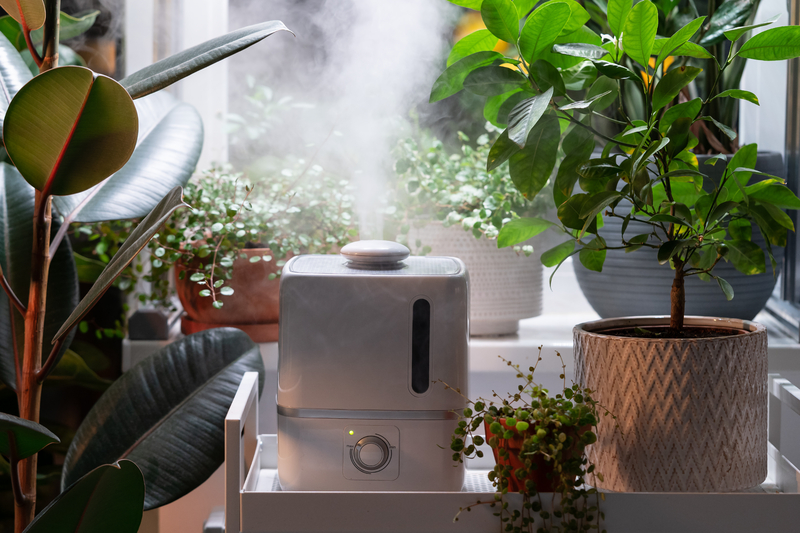
Let’s first look at other ways to increase the humidity levels in our homes before we delve into the world of the best plant humidifiers. You can try these alternatives if you’re not completely sold on the idea of buying a humidifier to support your plants.
Misting Your Plants
Misting different types of plants is a common error made by many novice plant owners. I was among those who believed that misting should occur daily! I’ve discovered the hard way that you should never mist plants with hairy leaves.
Or any other leaves that tend to keep the water in its place. This results in illnesses and spots on the leaves. Only temporarily can misting plants like orchids help to increase humidity.
Bathe Your Plants
Do you know about plant pool parties? It’s a humorous way of saying that you’re giving your humidity-loving plants a good bath in the bathtub or the shower. When they require the extra moisture in the winter, this can be done. Use warm water for this task, and clear away all the dust that has accumulated on the foliage while you’re at it.
Make Your own Humidity Tray
You can make your own humidity tray as a simple DIY project. Put water in a tray and layer pebbles on top. Place your plant atop. As the water in the tray evaporates, it increases the moisture in the air directly to the plant. Because they are not directly submerged in water, the roots won’t rot.
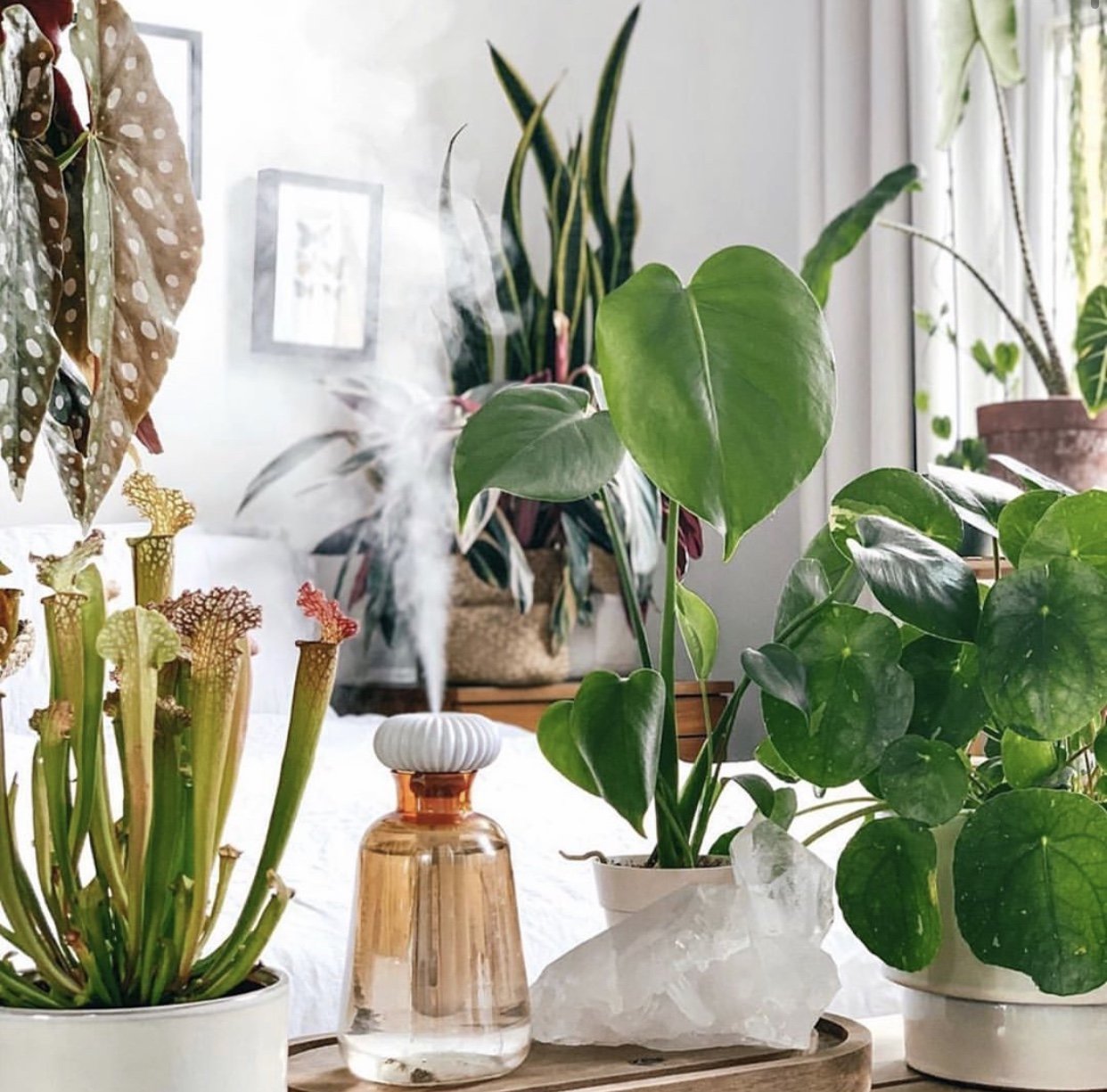
Grouping Your Plants Together
Grouping your plants has practical benefits beyond being just a styling advice. When several plants are placed together, a pocket or bubble of humidity is created. In the center, you can position a jar or a dish of water. Similar to rainforest canopies, the moisture this generates will be trapped in your plants’ microclimate!
Put Plants In High Humidity Rooms
Place your tropical plants in more humid spaces as a final “DIY” project to raise their humidity levels. The best plants that will thrive more when kept in bathrooms are listed in a Plants Spark Joy article. Your houseplants should be kept in this area if there is any area that is more humid than the rest.
All of these wonderful suggestions will undoubtedly prolong the life of your plants. However, they have a cap. A plant humidifier is the best option if you want to increase humidity in a real and superior way. We can try to persuade you further, but hopefully the list of humidifiers and what they can do below will encourage you to purchase your own device.
The following information will help you find the best humidifier for plants:
- Verify the fundamental operating concept. The majority of humidifiers come in a variety of styles, including the ultrasonic model, which is thought to be the most efficient, as well as evaporative and steam vaporizer options.
- Decide on the control type. Mechanical analog humidifiers require manual control, whereas digital electronics operate almost automatically.
- Decide whether you require warm or cool mist. Most humidifiers with warm mist were initially well-liked, but the risk of burns—especially to children—reduced their use. Nowadays, cool mists are the most popular type because they use less energy.
- Think about how simple it is to operate and maintain. More user-friendly humidifiers exist than others. So, take into account how simple it is to remove tanks for refilling, filter changes, and the accessibility of those accessories.
- What noise level do you consider tolerable. No humidifier is entirely silent. Others are loud, while others are quiet. Ultrasonic humidifiers are the quietest of all, though.
How To Select The Most Appropriate Plant Humidifier For Your Needs
Once you’ve exhausted all other options for raising plant humidity, you’ll come to the conclusion that investing in a plant humidifier is the most affordable and straightforward course of action. The better approach is to first consider your home and your needs rather than beginning this section with the brands you should choose.

The Best Plant Humidifiers For Your Home
If you’ve made up your mind to buy one, this list will enable you to choose the plant humidifier that most closely matches your preferences.
AIRCARE humidifiers – The new humidifier talk of the town.
Honeywell HCM350 Germ-Free Cool Mist Humidifier
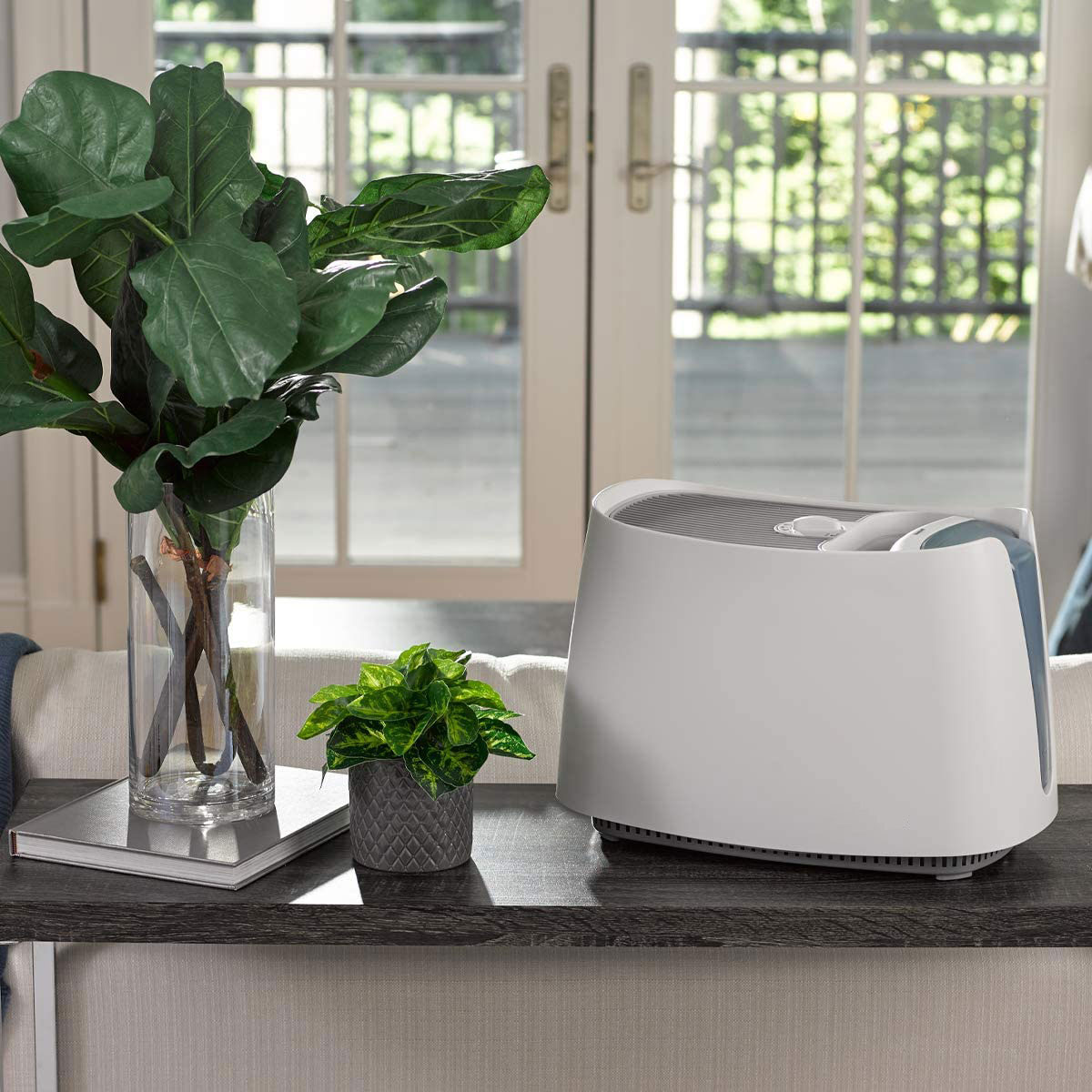
Being completely honest with you, this humidifier isn’t the most attractive on our list. If you have a small room, the design is a little intrusive and takes up a fair amount of space. However, that is really the main drawback of this humidifier. This tool works well, is more reasonably priced, and is efficient. We’re going to start with the Honeywell HCM350 for that reason.
Humidifier Highlights: Built-in humidistat, cool mist, 9.55 pounds, operates quietly, runs up to 24 hours.
This is the best humidifier for plants if you want to be able to go about your day or sleep through the night without worrying about how full your humidifier’s water tank is. Before requiring another round of filling, this unit can operate for up to 24 hours.
The Honeywell HCM350 has a quiet care technology design, which results in lower noise levels than other units. It is simple to clean thanks to its top-fill design. We’ve covered every fantastic feature of this device that makes it the top plant humidifier for your comfort.
Let’s now examine how your plants will benefit from this gadget. To begin with, it has three speeds that let you regulate and modify the amount of moisture output in your space. The Honeywell HCM350 has a built-in humidistat, which regulates humidity between a range of 40% and 60%, which is ideal for most houseplants.
You’ll be relieved to learn that this device has a chamber that uses ultraviolet lights to kill germs that are in the water if, like me, you’re concerned about germs in the air. They won’t be dispersed into the air and encourage the growth of mold. White dust is a different issue you won’t have with the Honeywell humidifier. You get a clean, cold mist that is ideal for your plants after the device’s wicking filter absorbs all the minerals from the water.
TaoTronics Cool Mist Humidifier

The appearance of a new addition to our homes is frequently the first factor we take into account. However, when it comes down to it, performance and cost are always the most important considerations. Users and reviewers frequently express this opinion of the TaoTronics Cool Mist Humidifier.
With warm or cool mist settings, LED display light, and all its other highlights, it’s a sure win. However, its 4-liter large water tank may be too big for some nightstands, and its utilitarian design may not go well with your houseplants.
Humidifier Highlights: 360-degree nozzle, automatic humidity monitoring, warm or cool mist selections, timer, and remote control.
I’ve discovered that this cool mist temperature humidifier might be the ideal humidifier for bedroom plants. This device operates quietly because it makes use of ultrasounds. The humidifier can be left on while you rest peacefully and comfortably. You can run the plant humidifier for 12 to 30 hours, depending on the mist level you select.
The appliance has a timer that can be set for up to 24 hours, and it also has a feature that automatically shuts off when the water level drops too low. In addition to the quiet operation feature, the three mist levels have a nighttime and sleep mode, so you won’t have to worry about LED display lights flashing in your bedroom. You can say goodbye to dry air at night and stay completely pitch black dark in your room!
This cool-mist humidifier has a ton of additional features that make it a great value. White dust is not left behind. You can direct the moisture you want inside your room with the help of the 360-degree rotatable nozzle on this device.
Pure Enrichment MistAire Ultrasonic Cool Mist Humidifier
:max_bytes(150000):strip_icc()/Horizontal_01-a10e0046f7ca4cc09e48856ce6b6fa3a.jpg)
This humidifier has a sizable water tank for its small size. This humidifier deserves a spot on our list of the best for plants, despite having a feature that some light sleepers might find bothersome (a light from the power button that won’t go out).
Humidifier Highlights: Mist nozzle with a 360-degree rotation, auto-shutoff, silent operation, and an add-on night light.
Because it is attractive, has a sleek base that fits perfectly in smaller spaces, has a long runtime, and has all the necessary features to be a dependable plant humidifier, the Pure Enrichment Ultrasonic Cool Mist Humidifier is a favorite among users. You have a 360-degree nozzle that aids in controlling the air mist. Because it has an auto-shutoff safety feature, it is secure. It differs from the other humidifiers on this list in part because of the optional night light, which emits a calming glow.
Evergreen Pet Supplies Humidifier

A brand that is made for pets but also works wonders for your indoor plants completes our list of humidifiers for plants. We don’t want you to assume that this humidifier is a feature simply because of the way it appears, but we do need to pause and admire the lovely design.
Humidifier Highlights: Cool mist humidifier, auto-shutoff, no-spill valve, ultrasonic, and large water tank capacity.
You can focus and completely control the mist’s output direction with the help of the unit’s adjustable hose, which you can attach to the device. You can bend it in any direction, and it has a suction cup. You have the auto-shutoff feature, keeping your mind at ease like the others on this list.
The no-spill valve is one of the most frequently mentioned features in most reviews. We can confirm that the Evergreen humidifier was the simplest to refill out of all those on this list. No messes or spills!
This list of the top plant humidifiers that we have tried and tested should give you an idea of what to look for when raising the humidity level in your space for your indoor plants. Always begin by thinking about your requirements, your capabilities, and your surroundings. When you have a clearer understanding of that, go back to this list and decide which humidifier is the most appropriate.
PureGuardian H8000B Ultrasonic cool and warm mist humidifiers
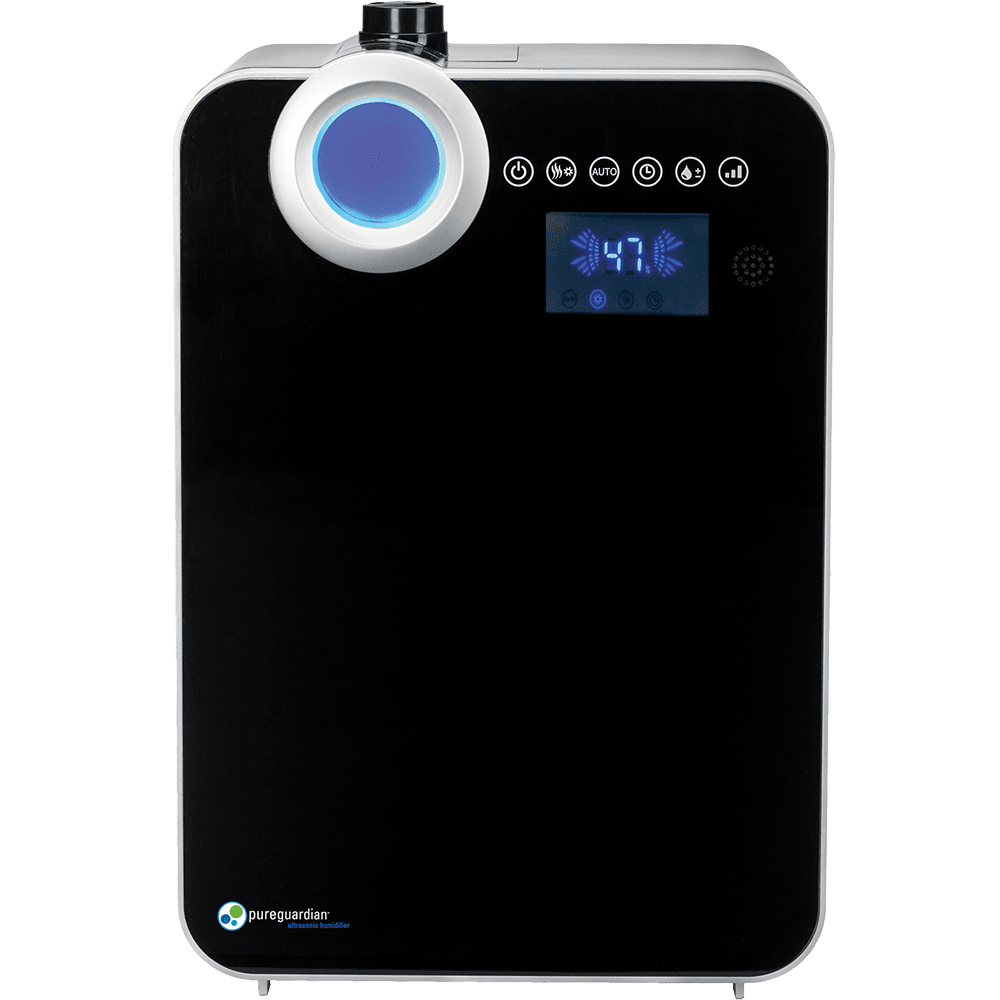
Do Plants Like Warm or Cool Air? Is a popular cool and warm mist model. In addition to having both mist options, it’s extremely quiet, includes antibacterial protection, and has an 12-hour timer. It also allows you to set your desired humidity level.
Humidifier Highlights: Conventional humidifiers frequently leave you in the dark regarding the humidity level in your space. You might be adding too much or too little moisture with such uncertainty. With its ground-breaking Smart Mist Technology, the PureGuardian 120-Hour Elite Ultrasonic Humidifier snuffs out this issue completely.
To set the desired humidity level between 40% and 75%, just use the humidifier’s simple digital controls. The humidifier will then run until the desired humidity level is reached and turn off appropriately to maintain it.
The ambient humidity of the room will be visible to you at all times on the display, so you can quickly learn how humid your room is. When you require a lot of dry air relief, you can also run the H8000B continuously.
One of PureGuardian’s premium tabletop humidifiers, the H8000B Warm or Cool Mist Elite Ultrasonic Humidifier has the features to back it up. This model has a 12-hour timer, a low water indicator with automatic shutoff, and warm and cool mist humidification to suit your needs.
A helpful cleaning brush that fits neatly inside the reservoir and two extended reach wands that increase the mist’s range in your room are also included.
A Matter of Preference: Cool vs. Warm Mist Humidifiers
Which is type of humidifier is best for you? For most people, it’s a matter of preference.
Have you been in a warm sauna? If you liked it and breathed easier, perhaps you will prefer a warm mist model better. If you struggled and didn’t like the sauna, a cool mist humidifier is likely a better bet.
However, if you’re looking for common pros for each type, consider these:
- Cool Mist: Typically covers more space and is preferred by parents since there’s not a heating element.
- Warm Mist: Are quieter than cool mist models and leaves your rooms feeling warm air
and cozier in the winter.
Again, cool mist humidifiers are more commonly purchased than humidifiers with warm mist simply because customers prefer cool mist.
FAQs on the best humidifier for plants:
Before we go, we’re answering some of the most frequently asked questions on humidifiers.
Are humidifiers good for plants?
Humidifiers help indoor plants retain more moisture which is beneficial and necessary for their growth. Adding a plant humidifier to your home is the best move you can do as a responsible plant parent.
There are other available ways to raise the humidity levels in your house, but a humidifier is the best and most effective option. Manually misting houseplants can raise the humidity level but it’s only effective for a short time. For this process to keep up with a humidifier, you would need to mist every 30 minutes!
What kind of humidifier do I need for plants?
Different factors determine which plant humidifier is best for you. Generally speaking, you should search for the following characteristics:
- 12-24 Hours Run Time – This function is useful! The water tank doesn’t need to be filled up all the time (and making spills).
- Home appliances should generally give us peace of mind with their auto-shutoff feature. When the water level is low, this feature merely turns the device off. You should have that level of safety!
- Simple to Operate – You shouldn’t feel as though you are launching a spacecraft to Mars. Simple buttons that are simple to set up and operate.
The best plant humidifier for you depends on different factors. Generally, you’ll want to look for the following features:
- 12-24 Hours Run Time – It’s a convenient feature! You don’t need to be constantly refilling the water tank (and making spills).
- Auto-Shutoff – generally, home devices should give us a peace of mind. This feature simply turns off the device when the water levels are low. And that’s safety you should have!
- Easy To Use – It shouldn’t feel like you’re launching a spaceship to Mars. Simple buttons, easy to set-up, easy to control.
When should you use a humidifier on plants?
A quick rule is to avoid using the humidifier at night for your plants. Water won’t evaporate if there is no sunlight. This will result in the soil becoming too wet, which will encourage the growth of bacteria and other organisms.
You should mist your plants in the morning and give them plenty of time during the day to dry out.
Can you use a diffuser as a humidifier for plants?
No. A quick rule is to avoid using the humidifier at night for your plants. Water won’t evaporate if there is no sunlight. This will result in the soil becoming too wet, which will encourage the growth of bacteria and other organisms. You should mist your plants in the morning and give them plenty of time during the day to dry out.
Why Is Humidity Important For Plants Only For Some Plants?
Plants need humidity to prevent drying out. For orchids and other exotic plants that are grown indoors as houseplants, it is essential.
However, if you want to grow vegetables like tomatoes or carrots, high humidity can be your enemy.
All year long, the humidity in rainforests can reach 100%. Because there is so much water available, the plants that grow there are unable to develop a strong root system. They do not require as much water as other plants to be drawn from the soil.
However, you must replicate the same humidity once you bring a plant from this environment into your home.
Remember that between 35 and 50 percent humidity is ideal indoors in the summer and between 15 and 25 percent in the winter.
Do I Need A Humidifier For My Plants?
The simplest test for this is to use a magnifying glass to examine them. Then look for wilted or dry patches on their leaves.
Consider the following when determining whether your plants require a humidifier:
- Which kind of plant are you cultivating?
- How large is your houseplant garden?
- Do you reside in a dry area or close to water bodies like lakes and oceans?
Each of these inquiries will help you choose which humidity level and how much your plants need.
What Type Of Plant Are You Growing?
This is the most important consideration when deciding whether you require a humidifier. Succulents and other plants with robust, thick leaves can survive without additional humidity. On the other hand, plants with delicate and thin leaves are more vulnerable to dry air.
Where Do You Live?
ILiving without plant humidifiers can worsen plant growth rates in many geographic areas.
Plants will require some additional moisture to flourish when you live in a climate that experiences drought.
You will need to humidify less frequently but should still exercise caution if you live in a tropical area with a lot of rain.
How Big Is Your Indoor Garden?
The most important consideration when choosing a humidifier type is the size of your garden. Humidifiers that produce warm or cool mist output work best in large spaces. In contrast, tabletop and ultrasonic models work better in small spaces.
What Kind Of Humidifier Is Best For Plants?
Plant humidifiers come in four different varieties. The humidifiers in question are warm mist, cool mist, ultrasonic, and evaporators. Each has advantages and disadvantages of its own, so pick the one that best suits your way of life!
- Cool Mist Humidifier
The most popular humidifier for plants is this one.
They provide the best efficiency and output rate of humidity combination. When operating at maximum efficiency, the release of water vapor can increase humidity by 30%.
Filter systems are used by cool-mist humidifiers. As a result, they are more energy-efficient than warm-mist humidifiers that use evaporation.
- Warm Mist Humidifiers
Warm mist humidifiers raise the humidity by producing heated steam from distilled or filtered water. They are perfect for gardens in greenhouses or conservatories that require high humidity levels.
The best mist to use in dry climates or when you need an extra boost of warmth in the winter is warm. It’s crucial to avoid running your appliance continuously. Energy costs will rise as a result of this with no additional benefits!
- Ultrasonic Humidifier
High-frequency sound is used by ultrasonic humidifiers to produce water vapor. They are the best and most expensive plant humidifiers. They don’t make noise like other types and can be used in any room without causing condensation on the walls or windows. For growing mushrooms, for instance, these are the best humidifiers.
- Evaporative Humidifier
To produce water vapor, an evaporative humidifiers circulates air using a fan through a wet wick filter or pad. It works best in a compact grow space.
However, because they use a fan to push air, they generate more noise than other humidifier models. Nevertheless, they typically consume less energy than other types.
Is A Warm Or Cool Mist Humidifier Better For Plants?
You might be wondering whether it matters if your humidifier puts out a warm mist or cold mist. The answer is no.
Most plants will do fine with a warm mist humidifier.
Still, keep in mind that you should also have a thermostat set at about 70 degrees Fahrenheit. If not, they might begin to wilt from the heat created by their pot and soil combined with a hot humidifier.
Can I use a regular humidifier for my plants?
As long as the humidifier is in the same room as your plants they’ll be fine. Personally, I keep my humidifier about 4-6 feet away from my plants. This gives the plants just enough space to breathe comfortably while still absorbing water vapors without becoming weak or soggy.
Should humidifier run all night for plants?
How long do you run a humidifier for plants? You should run your humidifier for at least 4 to 5 hours every day in the morning until midday. Running it too late into the afternoon risks leaving too much moisture in the air overnight when the plant doesn’t absorb it as much, which increases the risk for mold or fungus.
